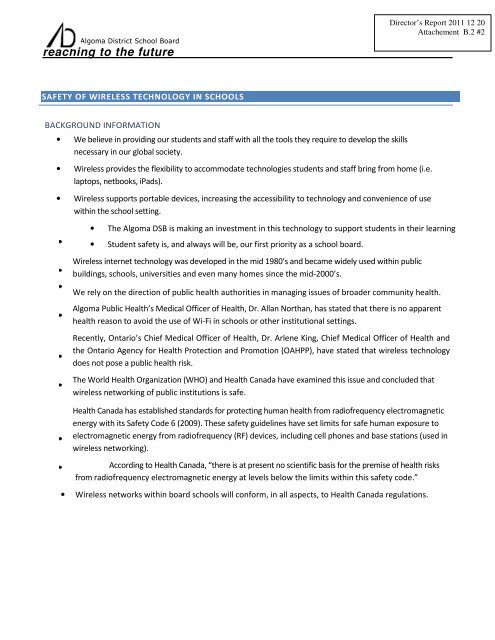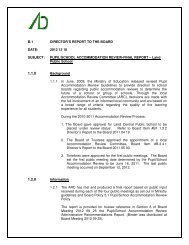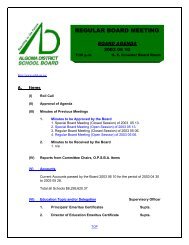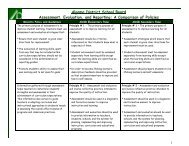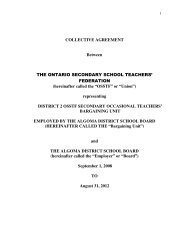Wireless Technology Use in Schools - Algoma District School Board
Wireless Technology Use in Schools - Algoma District School Board
Wireless Technology Use in Schools - Algoma District School Board
Create successful ePaper yourself
Turn your PDF publications into a flip-book with our unique Google optimized e-Paper software.
<strong>Algoma</strong> <strong>District</strong> <strong>School</strong> <strong>Board</strong>reach<strong>in</strong>g to the futureDirector’s Report 2011 12 20Attachement B.2 #2SAFETY OF WIRELESS TECHNOLOGY IN SCHOOLSBACKGROUND INFORMATION• We believe <strong>in</strong> provid<strong>in</strong>g our students and staff with all the tools they require to develop the skillsnecessary <strong>in</strong> our global society.• <strong>Wireless</strong> provides the flexibility to accommodate technologies students and staff br<strong>in</strong>g from home (i.e.laptops, netbooks, iPads).• <strong>Wireless</strong> supports portable devices, <strong>in</strong>creas<strong>in</strong>g the accessibility to technology and convenience of usewith<strong>in</strong> the school sett<strong>in</strong>g.• The <strong>Algoma</strong> DSB is mak<strong>in</strong>g an <strong>in</strong>vestment <strong>in</strong> this technology to support students <strong>in</strong> their learn<strong>in</strong>g• Student safety is, and always will be, our first priority as a school board.<strong>Wireless</strong> <strong>in</strong>ternet technology was developed <strong>in</strong> the mid 1980’s and became widely used with<strong>in</strong> publicbuild<strong>in</strong>gs, schools, universities and even many homes s<strong>in</strong>ce the mid-2000’s.We rely on the direction of public health authorities <strong>in</strong> manag<strong>in</strong>g issues of broader community health.<strong>Algoma</strong> Public Health’s Medical Officer of Health, Dr. Allan Northan, has stated that there is no apparenthealth reason to avoid the use of Wi-Fi <strong>in</strong> schools or other <strong>in</strong>stitutional sett<strong>in</strong>gs.Recently, Ontario’s Chief Medical Officer of Health, Dr. Arlene K<strong>in</strong>g, Chief Medical Officer of Health andthe Ontario Agency for Health Protection and Promotion (OAHPP), have stated that wireless technologydoes not pose a public health risk.The World Health Organization (WHO) and Health Canada have exam<strong>in</strong>ed this issue and concluded thatwireless network<strong>in</strong>g of public <strong>in</strong>stitutions is safe.Health Canada has established standards for protect<strong>in</strong>g human health from radiofrequency electromagneticenergy with its Safety Code 6 (2009). These safety guidel<strong>in</strong>es have set limits for safe human exposure toelectromagnetic energy from radiofrequency (RF) devices, <strong>in</strong>clud<strong>in</strong>g cell phones and base stations (used <strong>in</strong>wireless network<strong>in</strong>g).Accord<strong>in</strong>g to Health Canada, “there is at present no scientific basis for the premise of health risksfrom radiofrequency electromagnetic energy at levels below the limits with<strong>in</strong> this safety code.”• <strong>Wireless</strong> networks with<strong>in</strong> board schools will conform, <strong>in</strong> all aspects, to Health Canada regulations.


